brake TOYOTA MIRAI 2020 Owners Manual (in English)
[x] Cancel search | Manufacturer: TOYOTA, Model Year: 2020, Model line: MIRAI, Model: TOYOTA MIRAI 2020Pages: 56, PDF Size: 3.21 MB
Page 3 of 56
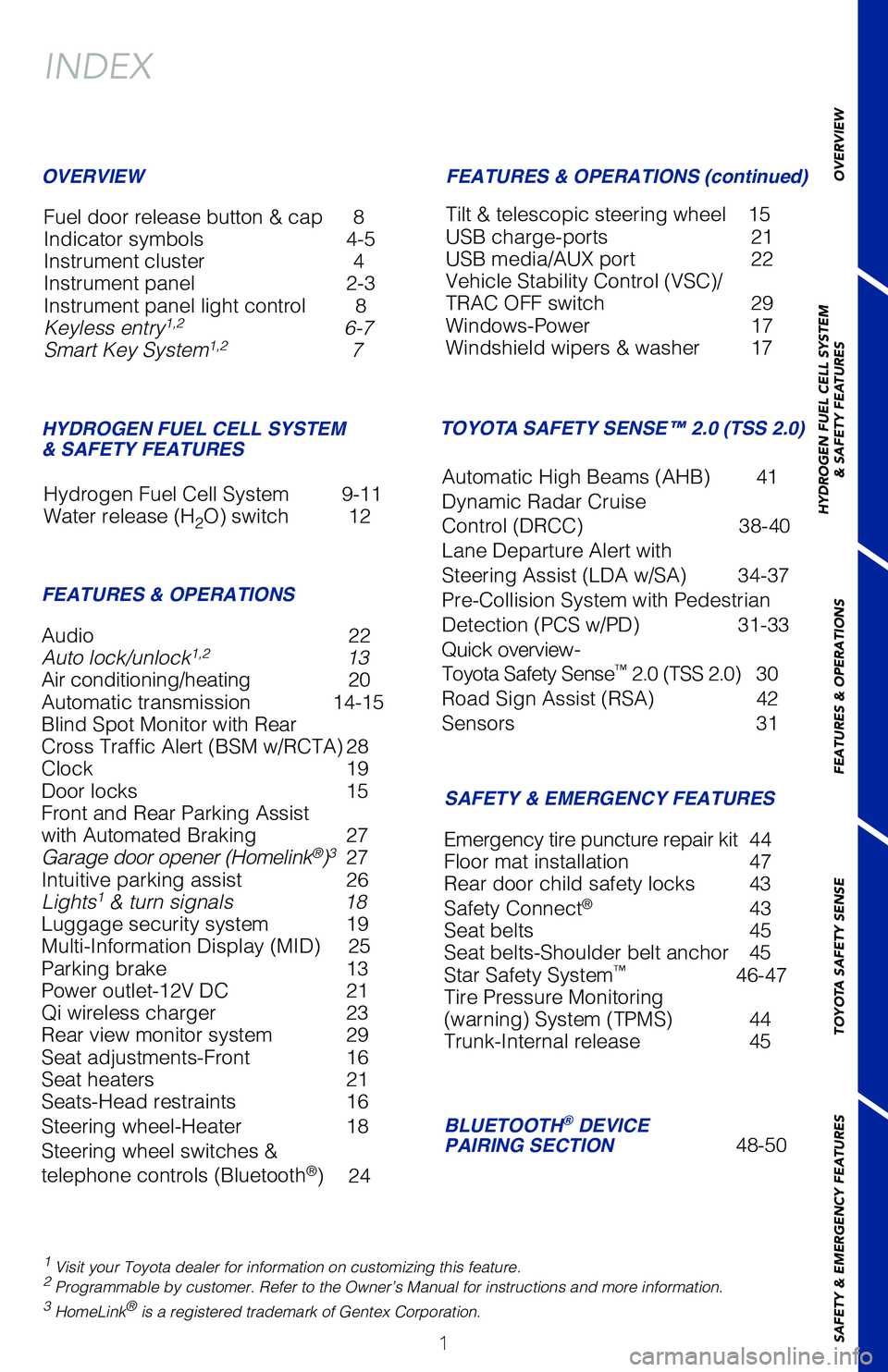
1
OVERVIEW
HYDROGEN FUEL CELL SYSTEM
& SAFETY FEATURES
FEATURES & OPERATIONS
TOYOTA SAFETY SENSE
SAFETY & EMERGENCY FEATURES
Audio 22
Auto lock/unlock1,213
Air conditioning/heating 20
Automatic transmission 14-15
Blind Spot Monitor with Rear
Cross Traffic Alert (BSM w/RCTA) 28
Clock 19
Door locks 15
Front and Rear Parking Assist
with Automated Braking 27
Garage door opener (Homelink
®)3 27
Intuitive parking assist 26
Lights
1 & turn signals 18
Luggage security system 19
Multi-Information Display (MID) 25
Parking brake 13
Power outlet-12V DC 21
Qi wireless charger 23
Rear view monitor system 29
Seat adjustments-Front 16
Seat heaters 21
Seats-Head restraints 16
Steering wheel-Heater 18
Steering wheel switches &
telephone controls (Bluetooth
®) 24
INDEX
Fuel door release button & cap 8
Indicator symbols 4-5
Instrument cluster 4
Instrument panel 2-3
Instrument panel light control 8
Keyless entry
1,26-7
Smart Key System1,27
Hydrogen Fuel Cell System 9-11
Water release (H
2O) switch 12
1 Visit your Toyota dealer for information on customizing this feature.2 Programmable by customer. Refer to the Owner’s Manual for instructio\
ns and more information.3 HomeLink® is a registered trademark of Gentex Corporation.
OVERVIEW
HYDROGEN FUEL CELL SYSTEM
& SAFETY FEATURES
FEATURES & OPERATIONS FEATURES & OPERATIONS (continued)
SAFETY & EMERGENCY FEATURES
Tilt & telescopic steering wheel 15
USB charge-ports 21
USB media/AUX port 22
Vehicle Stability Control (VSC)/
TRAC OFF switch 29
Windows-Power 17
Windshield wipers & washer 17
Emergency tire puncture repair kit 44
Floor mat installation 47
Rear door child safety locks 43
Safety Connect
®43
Seat belts 45
Seat belts-Shoulder belt anchor 45
Star Safety System
™46-47
Tire Pressure Monitoring
(warning) System (TPMS) 44
Trunk-Internal release 45
TOYOTA SAFETY SENSE™ 2.0 (TSS 2.0)
Automatic High Beams (AHB) 41
Dynamic Radar Cruise
Control (DRCC)38-40
Lane Departure Alert with
Steering Assist (LDA w/SA) 34-37
Pre-Collision System with Pedestrian
Detection (PCS w/PD) 31-33
Quick overview-
Toyota Safety Sense
™ 2.0 (TSS 2.0) 30
Road Sign Assist (RSA) 42
Sensors 31
BLUETOOTH® DEVICE
PAIRING SECTION48-50
Page 4 of 56
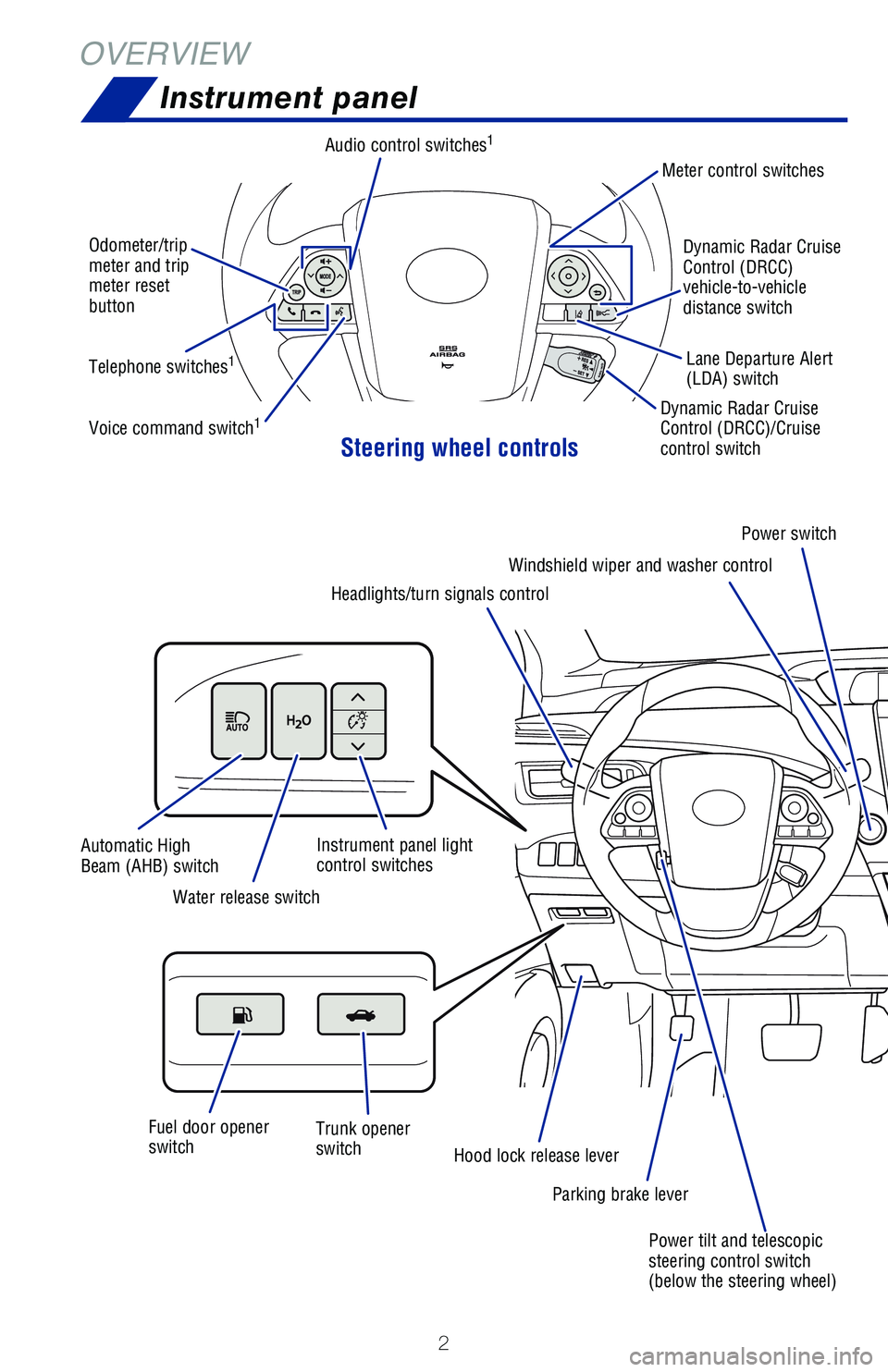
2
OVERVIEWInstrument panel
Steering wheel controls
Odometer/trip
meter and trip
meter reset
button
Telephone switches
1
Voice command switch1
Audio control switches1
Dynamic Radar Cruise
Control (DRCC)/Cruise
control switch
Power switch
Parking brake lever
Hood lock release lever
Trunk opener
switch
Fuel door opener
switch Water release switch
Automatic High
Beam (AHB) switch
Power tilt and telescopic
steering control switch
(below the steering wheel)
Instrument panel light
control switches
Meter control switches
Dynamic Radar Cruise
Control (DRCC)
vehicle-to-vehicle
distance switchLane Departure Alert
(LDA) switch
Headlights/turn signals control Windshield wiper and washer control
Page 6 of 56
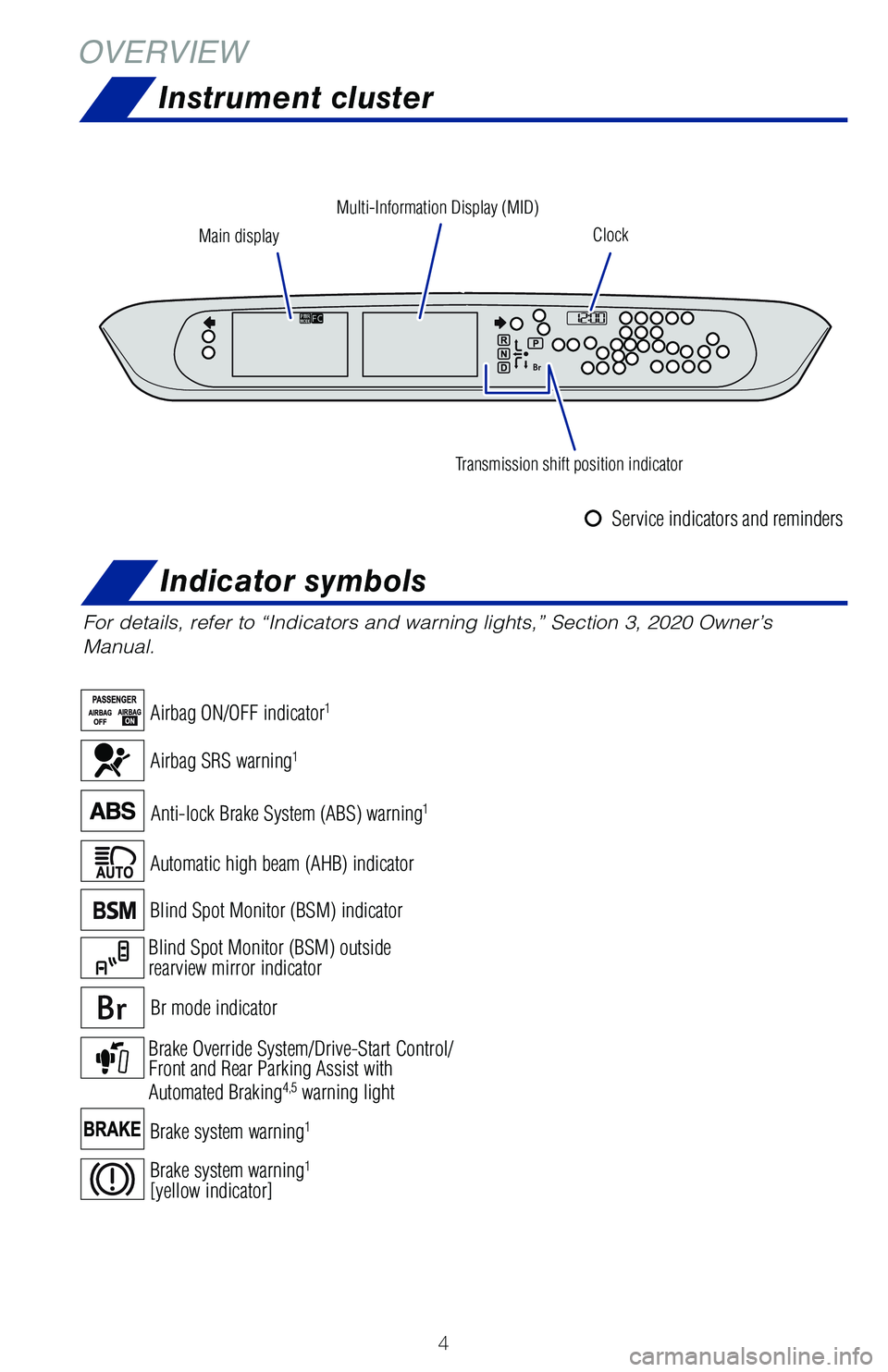
4
OVERVIEWInstrument cluster
For details, refer to “Indicators and warning lights,” Section 3, 2020 Owner’s
Manual.
Main display Clock
Transmission shift position indicator
Multi-Information Display (MID)
Automatic high beam (AHB) indicator
Airbag SRS warning1
Airbag ON/OFF indicator1
Br mode indicator
Blind Spot Monitor (BSM) indicator
Blind Spot Monitor (BSM) outside
rearview mirror indicator
Anti-lock Brake System (ABS) warning
1
Brake system warning1
Brake Override System/Drive-Start Control/
Front and Rear Parking Assist with
Automated Braking
4,5 warning light
Brake system warning1
[yellow indicator]
Indicator symbols
Service indicators and reminders
Page 7 of 56

5
Hydrogen leak warning
1
High coolant temperature warning1Slip indicator1,3
Steering control indicator
Vehicle Stability Control OFF indicator1
Low tire pressure warning1
Security indicator
Master warning1
Low fuel level warning
READY indicator
Headlight low/high beam indicator
Turn signal indicator
Shift position indicator
Open door warning
Driver’s and front passenger’s seat belt
reminder
(alarm will sound if speed is over
12 mph)
Charging system warning
H2O indicator
ECO mode indicator
POWER mode indicator
Pre-Collision System (PCS) warning1,2
Intuitive parking assist indicator
Constant speed cruise control
indicator/Constant speed cruise
control SET indicator
Dynamic Radar Cruise Control
(DRCC) indicator/DRCC SET
indicator
Electric power steering system warning1
[Red/yellow]
Lane Departure Alert (LDA) indicator
[Green/yellow]
Power restriction indicator
[Blue/yellow]
Parking brake warning
Front and Rear Parking Assist with
Automated Braking OFF indicator
1,2,4,5
1If the indicator does not turn off within a few seconds of starting the \
fuel cell system, there may
be a malfunction. Have the vehicle inspected by your Toyota dealer.
2If the indicator flashes, there may be a malfunction. Refer to the Owner\
’s Manual.3 If the indicator flashes, it indicates that the system is operating.4 If equipped.5 Refer to section PKSB (Parking Support Braking function) in the Owner\
’s Manual.
OVERVIEW
HYDROGEN FUEL CELL SYSTEM
& SAFETY FEATURES
FEATURES & OPERATIONS
TOYOTA SAFETY SENSE
SAFETY & EMERGENCY FEATURES
Page 9 of 56

7
Smart Key system
Push and hold
Without depressing the brake pedal, pressing the “POWER” switch wi\
ll change the
operation mode in succession from:
PANIC BUTTON
OVERVIEW
HYDROGEN FUEL CELL SYSTEM
& SAFETY FEATURES
FEATURES & OPERATIONS
TOYOTA SAFETY SENSE
SAFETY & EMERGENCY FEATURES
START FUNCTION
POWER (WITHOUT STARTING THE FUEL CELL SYSTEM)
NOTE: The Smart Key must be carried to enable the start function. With the
gear shift lever in Park and the brake pedal depressed, push the “POWER”
switch.
Off - All systems OFF. Emergency flashers can be used.
Accessory – Some electrical components can be used.
On - All electrical components can be used.
Page 11 of 56
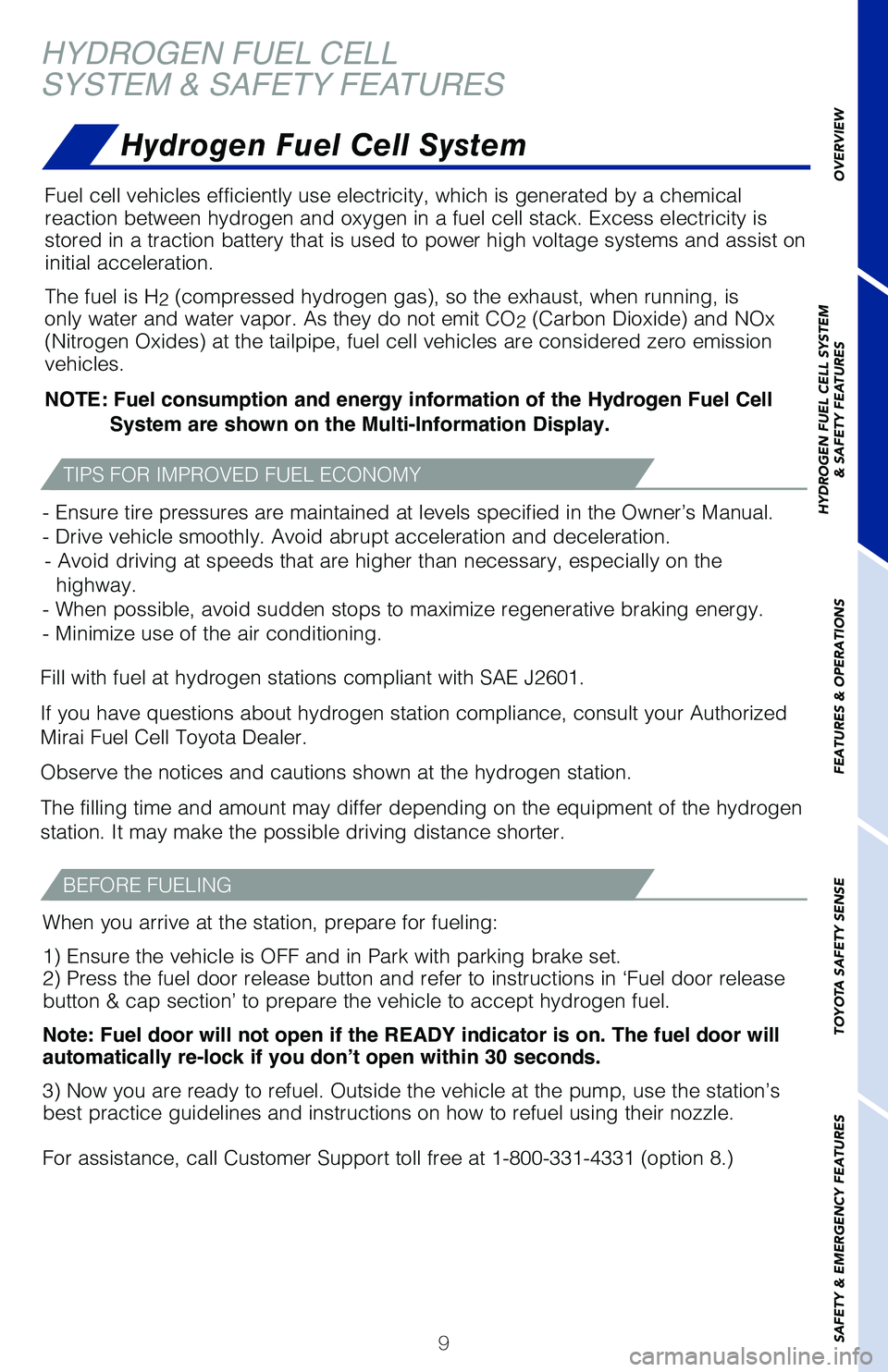
9
HYDROGEN FUEL CELL
SYSTEM & SAFETY FEATURES
Fuel cell vehicles efficiently use electricity, which is generated by a \
chemical
reaction between hydrogen and oxygen in a fuel cell stack. Excess electr\
icity is
stored in a traction battery that is used to power high voltage systems \
and assist on
initial acceleration.
The fuel is H
2 (compressed hydrogen gas), so the exhaust, when running, is
only water and water vapor. As they do not emit CO
2 (Carbon Dioxide) and NOx
(Nitrogen Oxides) at the tailpipe, fuel cell vehicles are considered zero emission
vehicles.
NOTE: Fuel consumption and energy information of the Hydrogen Fuel Cell
System are shown on the Multi-Information Display.
Fill with fuel at hydrogen stations compliant with SAE J2601.
If you have questions about hydrogen station compliance, consult your Authorized
Mirai Fuel Cell Toyota Dealer.
Observe the notices and cautions shown at the hydrogen station.
The filling time and amount may differ depending on the equipment of the\
hydrogen
station. It may make the possible driving distance shorter. - Ensure tire pressures are maintained at levels specified in the Owner’\
s Manual.
- Drive vehicle smoothly. Avoid abrupt acceleration and deceleration.
- Avoid driving at speeds that are higher than necessary, especially on \
the highway.
- When possible, avoid sudden stops to maximize regenerative braking energy.
- Minimize use of the air conditioning.
When you arrive at the station, prepare for fueling:
1) Ensure the vehicle is OFF and in Park with parking brake set.
2) Press the fuel door release button and refer to instructions in ‘Fuel door release button & cap section’ to prepare the vehicle to accept hydrogen fuel.\
Note: Fuel door will not open if the READY indicator is on. The fuel door will
automatically re-lock if you don’t open within 30 seconds.
3) Now you are ready to refuel. Outside the vehicle at the pump, use the station’s best practice guidelines and instructions on how to refuel using their nozzle.
For assistance, call Customer Support toll free at 1-800-331-4331 (option 8.)
OVERVIEW
HYDROGEN FUEL CELL SYSTEM
& SAFETY FEATURES
FEATURES & OPERATIONS
TOYOTA SAFETY SENSE
SAFETY & EMERGENCY FEATURES
Hydrogen Fuel Cell System
TIPS FOR IMPROVED FUEL ECONOMY
BEFORE FUELING
Page 15 of 56

13
FEATURES & OPERATIONSAuto lock/unlock
Automatic door locks can be programmed to operate in different modes, or\
turned OFF.
Shift position linked door locking/unlocking function
-Doors lock when shifting to any positions other than P.
-Doors unlock when shifting into P.
Speed linked door locking function
-Doors lock when the vehicle speed is approximately 12 mph or higher.
Driver’s door linked door unlocking function
-Doors unlock when the driver’s door is opened.
Refer to the Owner’s Manual for more details.
Parking brake
P POSITION SWITCH
The shift position can be changed to P through the use of the P position\
switch.
Set: Depress
Release: Depress again
Push
(1) Fully stop the vehicle
(2) Keep depressing the brake pedal
(3) Press the P position switch.
OVERVIEW
HYDROGEN FUEL CELL SYSTEM
& SAFETY FEATURES
FEATURES & OPERATIONS
TOYOTA SAFETY SENSE
SAFETY & EMERGENCY FEATURES
Page 29 of 56

27
Garage door opener (Homelink®)*
Garage door openers manufactured under license from HomeLink®* can be
programmed to operate garage doors, estate gates, security lighting, etc\
.
Refer to “Garage door opener,” Section 6-4 in the Owner’s Manua\
l for more details.
For programming assistance, contact HomeLink
® at 1-800-355-3515, or visit http://
www.homelink.com/toyota.
* HomeLink® is a registered trademark of Gentex Corporation.
Homelink®indicator light
Homelink®icon -
illuminates while operating
Garage door operation indicatorsButtons
Front and Rear Parking Assist with Automated
Braking
(if equipped)
When a collision may occur with an obstacle while parking or traveling a\
t low
speeds, when the vehicle suddenly moves forward due to mistaken accelera\
tor
pedal operation, or when the vehicle moves due to the wrong shift positi\
on being
selected, the sensors are designed to detect obstacles to the front or r\
ear in the
traveling direction of the vehicle, and the system operates to lessen im\
pact with
obstacles such as walls, and reduce resulting damage.
CHANGE SETTINGS
Note: Use, and of the meter control switches to select
and in the Multi-Information Display (MID) to change settings. The system
will continue in the last state it was in (ON or OFF) when the ignition is turned
on again.
Refer to section PKSB (Parking Support Brake function) in the Owner’\
s Manual for
limitations and more details.
OVERVIEW
HYDROGEN FUEL CELL SYSTEM
& SAFETY FEATURES
FEATURES & OPERATIONS
TOYOTA SAFETY SENSE
SAFETY & EMERGENCY FEATURES
Page 33 of 56
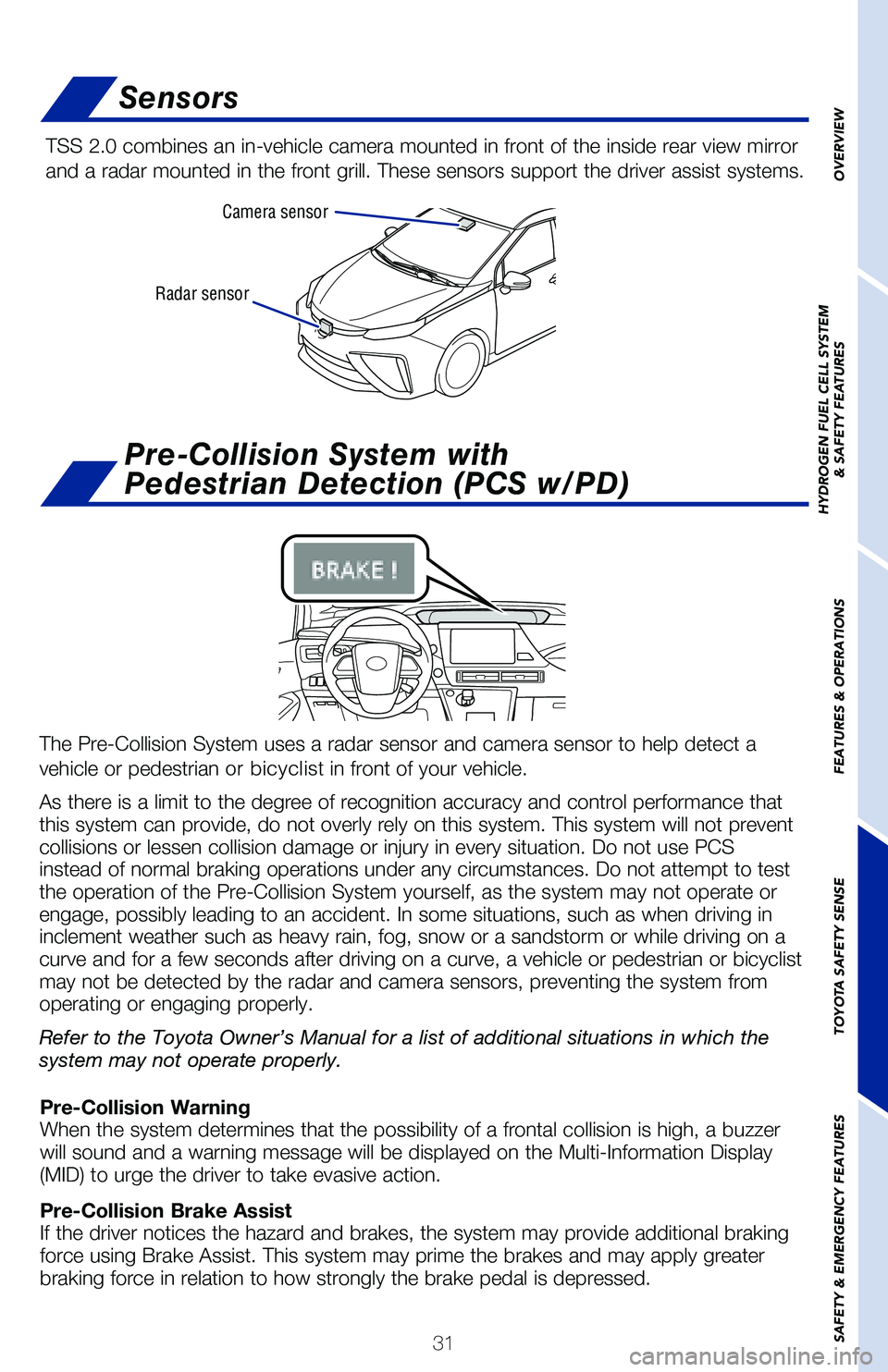
31
Radar sensorCamera sensor
Sensors
TSS 2.0 combines an in-vehicle camera mounted in front of the inside rea\
r view mirror
and a radar mounted in the front grill. These sensors support the driver\
assist systems.
The Pre-Collision System uses a radar sensor and camera sensor to help d\
etect a
vehicle or pedestrian or bicyclist in front of your vehicle.
As there is a limit to the degree of recognition accuracy and control pe\
rformance that
this system can provide, do not overly rely on this system. This system \
will not prevent
collisions or lessen collision damage or injury in every situation. Do n\
ot use PCS
instead of normal braking operations under any circumstances. Do not att\
empt to test
the operation of the Pre-Collision System yourself, as the system may no\
t operate or
engage, possibly leading to an accident. In some situations, such as whe\
n driving in
inclement weather such as heavy rain, fog, snow or a sandstorm or while \
driving on a
curve and for a few seconds after driving on a curve, a vehicle or pedes\
trian or bicyclist
may not be detected by the radar and camera sensors, preventing the syst\
em from
operating or engaging properly.
Refer to the Toyota Owner’s Manual for a list of additional situation\
s in which the
system may not operate properly.
Pre-Collision Warning
When the system determines that the possibility of a frontal collision i\
s high, a buzzer
will sound and a warning message will be displayed on the Multi-Informat\
ion Display
(MID) to urge the driver to take evasive action.
Pre-Collision Brake Assist
If the driver notices the hazard and brakes, the system may provide addi\
tional braking
force using Brake Assist. This system may prime the brakes and may apply\
greater
braking force in relation to how strongly the brake pedal is depressed.
Pre-Collision System with
Pedestrian Detection (PCS w/PD)
OVERVIEW
HYDROGEN FUEL CELL SYSTEM
& SAFETY FEATURES
FEATURES & OPERATIONS
TOYOTA SAFETY SENSE
SAFETY & EMERGENCY FEATURES
Page 34 of 56
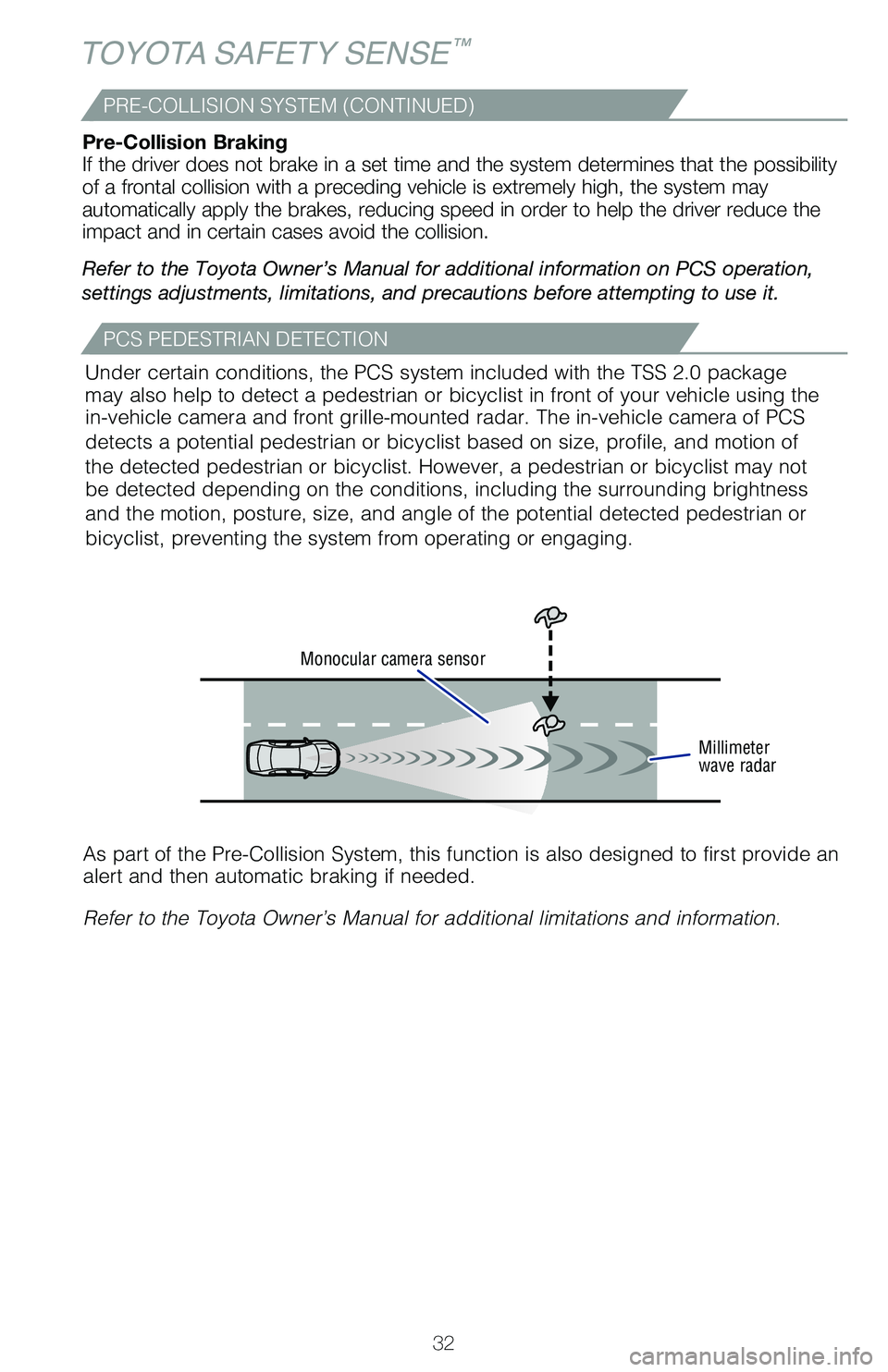
32
PRE-COLLISION SYSTEM (CONTINUED)
TOYOTA SAFETY SENSE™
Refer to the Toyota Owner’s Manual for additional information on PCS \
operation,
settings adjustments, limitations, and precautions before attempting to \
use it. Pre-Collision Braking
If the driver does not brake in a set time and the system determines tha\
t the possibility
of a frontal collision with a preceding vehicle is extremely high, the s\
ystem may
automatically apply the brakes, reducing speed in order to help the driv\
er reduce the
impact and in certain cases avoid the collision.
Monocular camera sensorMillimeter
wave radar
As part of the Pre-Collision System, this function is also designed to f\
irst provide an
alert and then automatic braking if needed.
Refer to the Toyota Owner’s Manual for additional limitations and inf\
ormation.Under certain conditions, the PCS system included with the TSS 2.0 packa\
ge
may also help to detect a pedestrian or bicyclist in front of your vehic\
le using the
in-vehicle camera and front grille-mounted radar. The in-vehicle camera \
of PCS
detects a potential pedestrian or bicyclist based on size, profile, and motion of
the detected pedestrian or bicyclist. However, a pedestrian or bicyclist\
may not
be detected depending on the conditions, including the surrounding brigh\
tness
and the motion, posture, size, and angle of the potential detected pedestrian
or
bicyclist, preventing the system from operating or engaging.
PCS PEDESTRIAN DETECTION